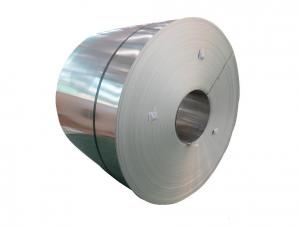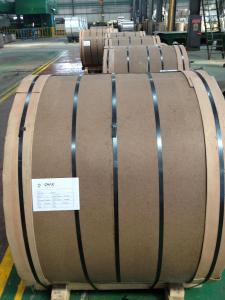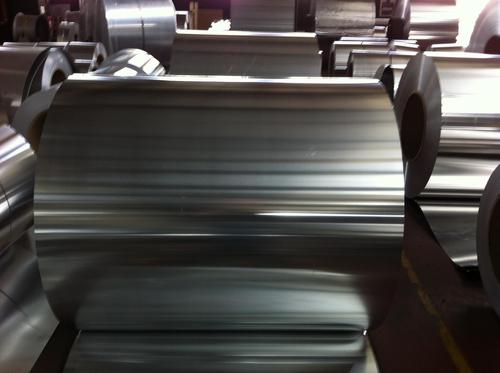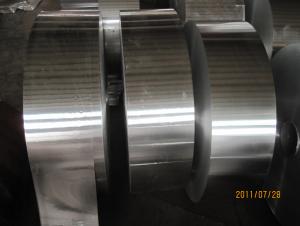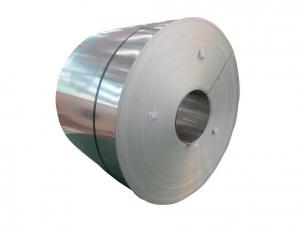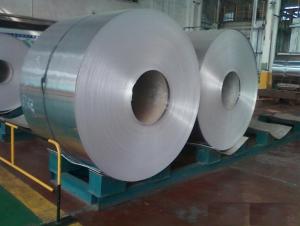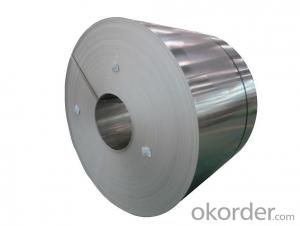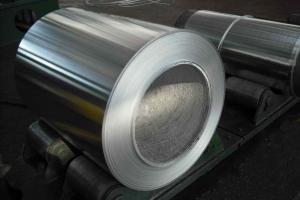Trane Aluminum Coil - Continuous Casting Aluminium Strip in Coils AA1050
- Loading Port:
- China Main Port
- Payment Terms:
- TT or LC
- Min Order Qty:
- -
- Supply Capability:
- -
OKorder Service Pledge
OKorder Financial Service
You Might Also Like
1.Structure of Product Description
Continuous Casting Aluminium Strip in Coil is one semi-finished aluminium material. This strip can be rolled down to aluminium coil,sheet,circle ect. The alloy AA1050 is widly used in building, industry ect. Its weight is much lower than steel. So many customers choosed aluminium material instead of steel.
2. Main features of the product
a.Competitive price---We have our own mills and can produce mill finished aluminium coils, so we can control the production cost better.
b.Professional after-sale service---We have more than 15 years exportation experience and you need not worry about the exporation problems.
c.Fast delivery time---We can control the delivery time within 35 days.
3. Image
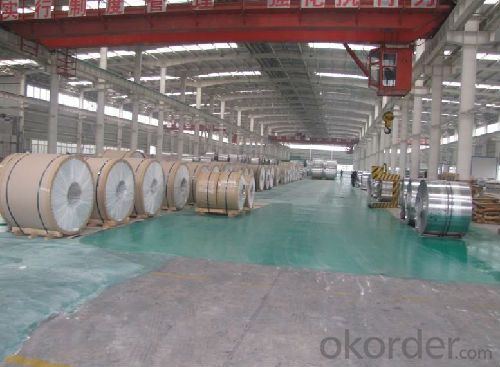
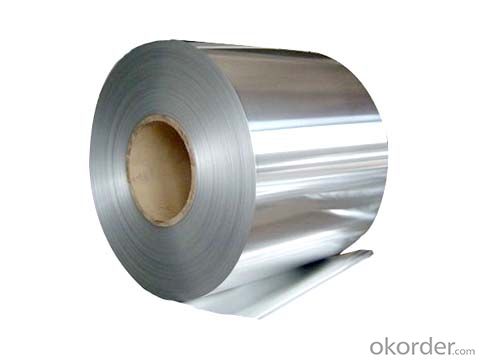

4.Products Specification
| Alloy | Final Usage | Coil ID | Coil Weight | Thickness |
| AA1050 | Aluminium coil/circle | 610mm +/-10mm | Min 5 tons | 3-8mm |
5. FAQ
What is the quality standard?
---Usually our standard is GB3880-2006
What is the largest width?
---It is 2300mm
What is the MOQ?
---Usually we can accept 80 tons.
- Q: G'day guys, I'm wanting to get the tinnie out but im not looking on spending to much on oars, Aluminum ones are quite cheap i can pick some up for $50, but i was just wondering if there any good? anyone had good or bad experience with them? and would it just be worth forking out extra for wooden ones?
- Cheap Oars
- Q: What is the thickness range of aluminum coils?
- The thickness range of aluminum coils typically varies between 0.15mm to 4mm.
- Q: What are the rules and regulations regarding the use of aluminum coil in commercial kitchen settings?
- <p>Yes, there are regulations on the use of aluminum coil in commercial kitchens. These regulations often relate to food safety, hygiene, and the material's suitability for contact with food. Aluminum is generally safe for food contact, but it must meet specific standards to ensure it does not leach harmful substances into food. Regulations may vary by country or region, with some areas having strict guidelines on the types of aluminum alloys allowed and their intended use. Compliance with these regulations is crucial to avoid health risks and legal penalties. It's important for commercial kitchens to use food-grade aluminum and to follow local health department guidelines.</p>
- Q: This question asks about the various classifications of aluminum coil based on their properties and applications.
- <p>Aluminum coils are categorized into different grades based on their alloy composition and applications. The most common grades include 1000 series (99% pure aluminum), 3000 series (aluminum-manganese alloys), 5000 series (aluminum-magnesium alloys), and 6000 series (aluminum-magnesium-silicone alloys). Each grade has unique properties such as formability, strength, and corrosion resistance, which make them suitable for specific applications like construction, transportation, and packaging. The selection of the grade depends on the performance requirements of the end product.</p>
- Q: Can aluminum coils be used in architectural applications?
- Yes, aluminum coils can be used in architectural applications. Aluminum is a versatile and durable material that is commonly used in the construction industry for its lightweight nature, corrosion resistance, and ease of fabrication. Aluminum coils are often utilized in architectural applications such as roofing, cladding, and facades due to their ability to be easily formed into various shapes and sizes. Additionally, aluminum coils can be coated with different finishes to enhance their aesthetics and provide additional protection against weathering and fading. Overall, aluminum coils are a popular choice for architectural applications as they offer a combination of functionality, aesthetics, and longevity.
- Q: Is it possible to utilize aluminum coils in creating art pieces or decorative items?
- <p>Yes, aluminum coils can be used to make artworks or decorations. Aluminum's malleability and durability make it an excellent material for crafting. It can be bent, twisted, and shaped into various forms, allowing for creative expression in art and design. Additionally, aluminum's resistance to corrosion and weathering makes it suitable for both indoor and outdoor decorative pieces. Artists often appreciate its lightweight nature and the metallic finish that can be polished or painted, offering versatility in artistic applications.</p>
- Q: Can aluminum coils be insulated?
- Indeed, insulation can be applied to aluminum coils. It is a widespread practice to enhance energy efficiency and avoid heat loss or gain. Usually, the insulation material envelops the aluminum coil, creating a safeguarding coating that minimizes thermal transfer. This insulation method contributes to preserving the desired temperature within the coil and averting detrimental condensation. Moreover, insulation additionally enhances the overall functionality and durability of the aluminum coil system.
- Q: Are there any specific guidelines for the installation of aluminum coils?
- Specific guidelines exist for the installation of aluminum coils. When installing aluminum coils, it is crucial to adhere to the manufacturer's instructions and industry standards. Some guidelines to consider are: 1. Handling: Take caution when handling aluminum coils to prevent damage. It is recommended to use gloves and avoid dropping or dragging the coils during installation. 2. Compatibility: Confirm that the aluminum coils are suitable for the HVAC system being installed. Factors such as coil size, capacity, and refrigerant type should be taken into account. 3. Coil orientation: Pay attention to the proper orientation of the coil during installation, ensuring that the airflow direction aligns with the system's requirements. 4. Alignment: Proper alignment of the aluminum coil is essential for efficient operation. Ensure that the coil is level and securely attached to the mounting brackets. 5. Condensate drainage: Proper installation and functioning of condensate drain pans and lines are necessary to prevent water leakage and potential damage. 6. Electrical connections: Adhere to the manufacturer's electrical guidelines to ensure correct wiring and connections for the aluminum coil. 7. Insulation: Insulate refrigerant lines and ductwork as needed to prevent condensation and improve energy efficiency. 8. Clearances: Maintain sufficient clearances around the aluminum coil to facilitate proper airflow and service access. This includes allowing enough space for cleaning and maintenance. 9. Testing: After installation, perform necessary tests and inspections to verify the proper functioning of the aluminum coil. This may involve checking for refrigerant leaks, ensuring proper airflow, and testing system performance. Before installing aluminum coils, it is important to consult the manufacturer's installation instructions and any applicable building codes or regulations. Following these specific guidelines will contribute to a successful installation and optimal performance of the aluminum coils.
- Q: The user is asking if it's possible to use an electric welder for joining aluminum coils.
- <p>Yes, you can use an electric welder to weld aluminum coils together. However, it's important to use the correct type of welder and settings. Gas tungsten arc welding (GTAW), also known as TIG welding, is commonly used for aluminum due to its precision and ability to control heat input. MIG (Metal Inert Gas) welding can also be used for thicker aluminum materials. Ensure you use the right filler material, a suitable welding current, and proper shielding gas to prevent oxidation. Always follow safety precautions and consult with a professional if you're unsure about the welding process.</p>
- Q: How do aluminum coils contribute to energy efficiency in buildings?
- Aluminum coils contribute to energy efficiency in buildings by improving the heating and cooling systems. These coils are commonly used in HVAC systems, where they help in transferring heat effectively. The high thermal conductivity of aluminum allows for faster heat transfer, resulting in more efficient cooling and heating processes. Additionally, aluminum coils are lightweight and corrosion-resistant, reducing the load on the HVAC system and ensuring its longevity. Overall, the use of aluminum coils in buildings helps to conserve energy and reduce utility costs.
Send your message to us
Trane Aluminum Coil - Continuous Casting Aluminium Strip in Coils AA1050
- Loading Port:
- China Main Port
- Payment Terms:
- TT or LC
- Min Order Qty:
- -
- Supply Capability:
- -
OKorder Service Pledge
OKorder Financial Service
Similar products
Hot products
Hot Searches
Related keywords

